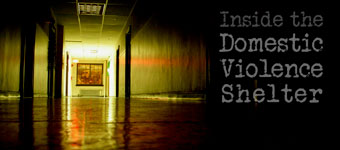
Inside Story: Domestic Violence Shelters
 Submitted by Anonymous
Submitted by Anonymous
I have worked as a counselor in a domestic violence shelter in the Midwest for more than five years. I enjoyed my job when it was legitimate, when I was helping an actual victim of domestic violence overcome their past, their trauma, and move on with their lives.
However, day-by-day, week-by-week, it became more and more obvious that the business of domestic violence and my belief in what the true goal of our shelter should be were two very different animals.
The business of domestic violence is exactly that – a business only concerned with numbers, statistics, and money (generally in the form of donations). I believe this is incredibly detrimental to actual victims of domestic violence.
These shelters also make it extremely tempting to people to lie about abuse in order to present themselves as a victim of domestic violence so they would qualify for shelter care.
Thus, I have agreed to write a series of articles for MensRights.com from the viewpoint of someone who was actually there on the inside to expose the truth of what goes on in a domestic violence shelter.
Domestic violence laws.
I am fully in favor of domestic violence laws and the protection they provide for victims of domestic violence. However, I believe that in many cases the laws are abused, as are the resources and protections the laws provide for victims in the form of shelters and advocacy.
I believe that everyone should have the same access to protection from domestic violence whether that is a family member, a person who is in a dating relationship, cohabiting partners, or spouses.
However, not all persons are able to meet the criteria for a domestic violence order, whereas others who should not meet the criteria can take advantage of the laws, sometimes for years.
Why would someone want to qualify for entry into a domestic violence shelter as opposed to a run-of-the-mill homeless shelter?
As many of the residents in our shelter said, domestic violence shelters are much nicer and have less stringent rules.
Many homeless shelters require their clients to leave early in the morning and only allow them back later in the evening. They may require their clients to take drug tests, to actively apply for employment, or even to perform community service in order to remain in shelter.
Also, typical homeless shelters often are set up dormitory style, many bunk beds in one room and gym-style showers. In domestic violence shelters, few requirements are placed on residents and they often have their own bedroom. They are fed well, clothed, and generally have a very comfortable stay.
Who meets the criteria for entry into domestic violence shelters?
 I cannot answer for every shelter, but as for the one that I worked in for many years and the other shelters that we cooperated with, the criteria is extremely easy to meet. The person requesting shelter is not required to have a restraining order, emergency protection order, or domestic violence order.
I cannot answer for every shelter, but as for the one that I worked in for many years and the other shelters that we cooperated with, the criteria is extremely easy to meet. The person requesting shelter is not required to have a restraining order, emergency protection order, or domestic violence order.
Often, all the caller would have to say is that the perpetrator “yelled” at them or was “emotionally abusive.”
It is all about the numbers.
Shelters depend on grants and donations, and in order to receive grants and donations, shelters must be able to show that they serve a number of clients. It is in the shelter’s best interest to serve as many clients as possible.
Therefore, counselors and other staff are instructed to basically take anyone who calls requesting shelter. On the one hand, there is a legitimate reason for this – nobody wants to refuse shelter to someone who is truly being abused, and, perhaps due to lack of a safe place to escape to, ends up severely beaten or killed.
On the other hand, it makes the numbers look impressive to potential donors. The outcome of this deceitful playing with who meets criteria for entry is that there statistically appears to be many more victims of domestic violence assisted by domestic violence shelters than there truly are.
Therefore, shelters tend to accept nearly everyone who calls. The caller may even end up being the abuser/perpetrator. This has happened on more than one occasion. The caller may simply be homeless.
Now, I fully believe that the homeless need shelter, but they do not require the special services of a domestic violence shelter. Substance abusers and the mentally ill fill many beds in shelters. Of course, often substance abusers and the mentally ill are victims of domestic violence. However, more often than not, they are simply homeless due to their specific problems.
Being “shelter smart.”
There is an entire population that goes from shelter to shelter. Once they’ve worn out their welcome in one shelter, they move on to the next. And these people are very “shelter smart.” They prefer domestic violence shelters because they tend to be more comfortable than other homeless shelters.
Domestic violence shelters are more apt to provide medications. They provide transportation to their clients and many offer recreational outings, arts and crafts, and other activities that may be considered therapeutic to a victim of trauma.
 True victims of abuse often suffer from post-traumatic stress disorder, depression and/or anxiety as well as physical pain from injuries. Often they run, leaving their home for safety reasons, and do not have access to their insurance. For these reasons, shelters will often supply at least the first month’s supply of medication.
True victims of abuse often suffer from post-traumatic stress disorder, depression and/or anxiety as well as physical pain from injuries. Often they run, leaving their home for safety reasons, and do not have access to their insurance. For these reasons, shelters will often supply at least the first month’s supply of medication.
However, on more than one occasion, a client who is not a victim of domestic violence has come into shelter for the single, sole purpose of getting medication. Each domestic shelter has its own rules and regulations, but most provide for necessary medication whether that is ibuprofen or medications for anxiety or depression. Once the client received their medications, they would leave the next day.
Unlike some homeless shelters, domestic violence shelters generally do not require anything of their clients. They are not required to look for employment, housing, or further education. Indeed, if they choose to lie in bed all day, domestic violence shelters provide child advocates to look after their children.
Many domestic violence advocates state that forcing them to work towards goals that the shelter sets for them is “revictimizing” them. In essence, the shelter is taking over the role of the perpetrator in ordering them about and making their decisions for them.
Therefore, there are no real consequences if they do not abide by shelter rules. To have consequences or punishments is to “revictimize” them.
If the shelter “holds threats over their heads” in stating that they will be asked to leave if they do not do their assigned tasks, or if they do not keep their room clean, or if they do not supervise their children, they are “revictimizing” them.
If I were homeless, there is no doubt I would much rather be homeless in a domestic violence shelter rather than a generic homeless shelter.
That would make it extremely tempting to lie in order to present myself as a victim of domestic violence so that I would qualify, don’t you think?
If you are a victim of domestic violence or need to file a restraining order against an abusive family member, contact the men’s rights attorneys of Cordell & Cordell.
